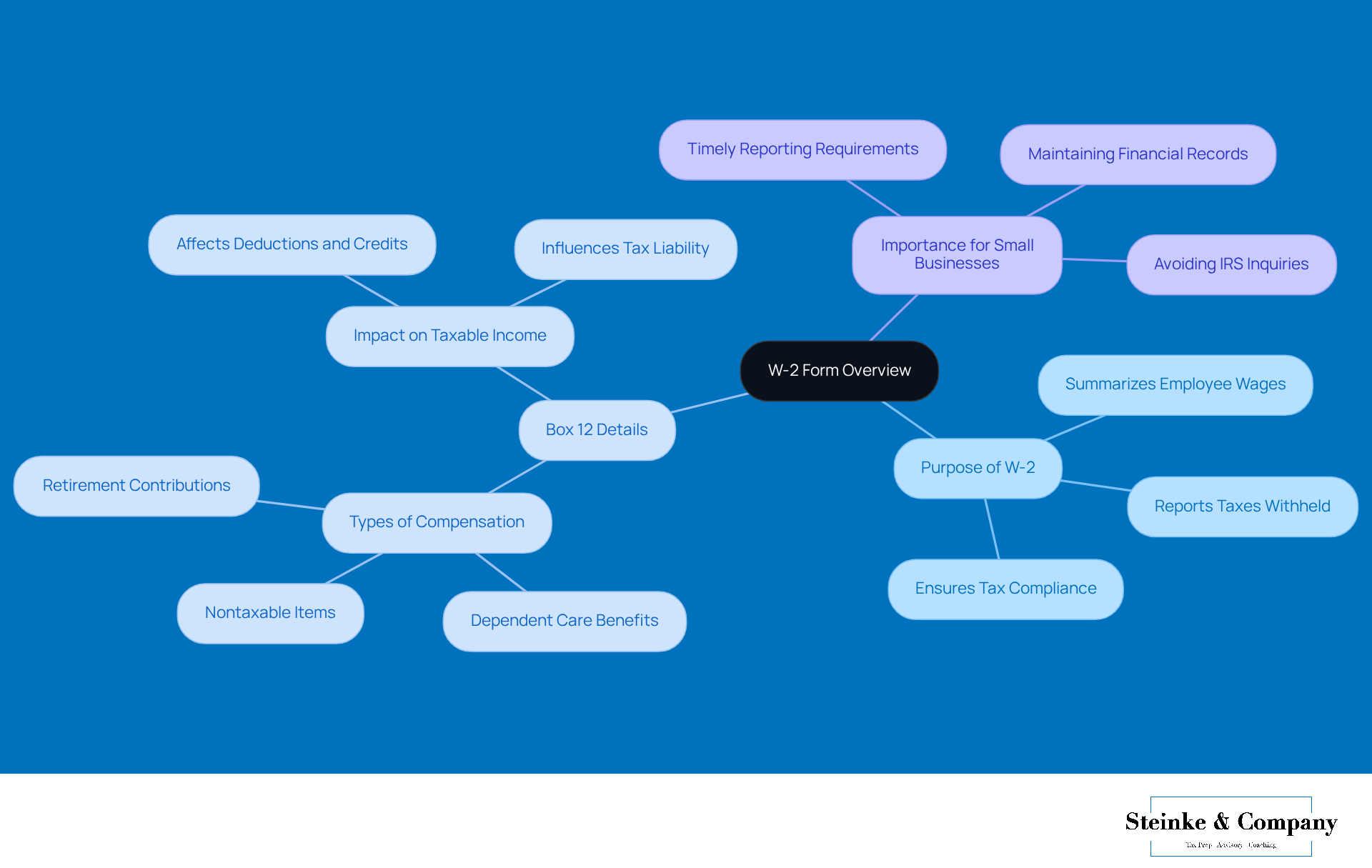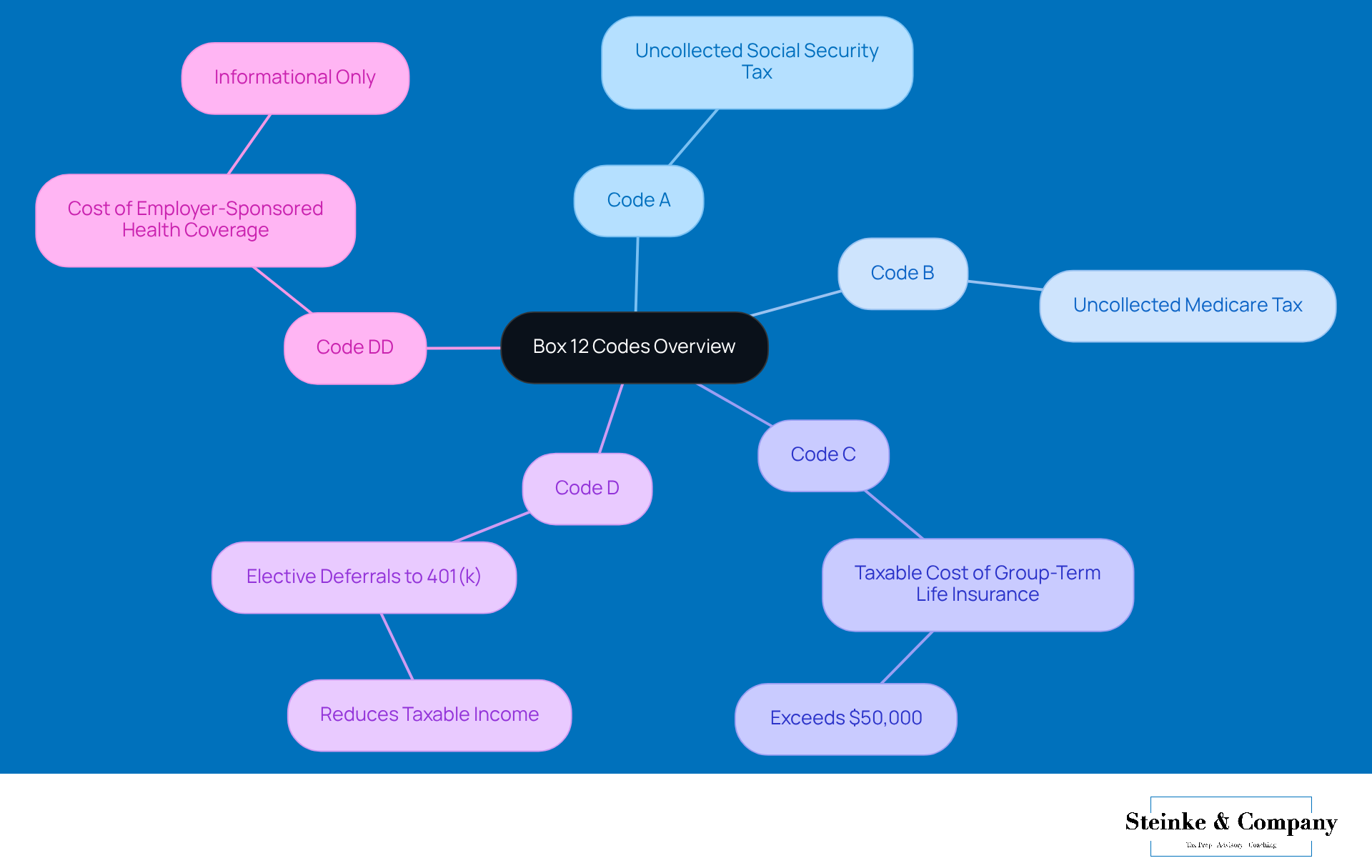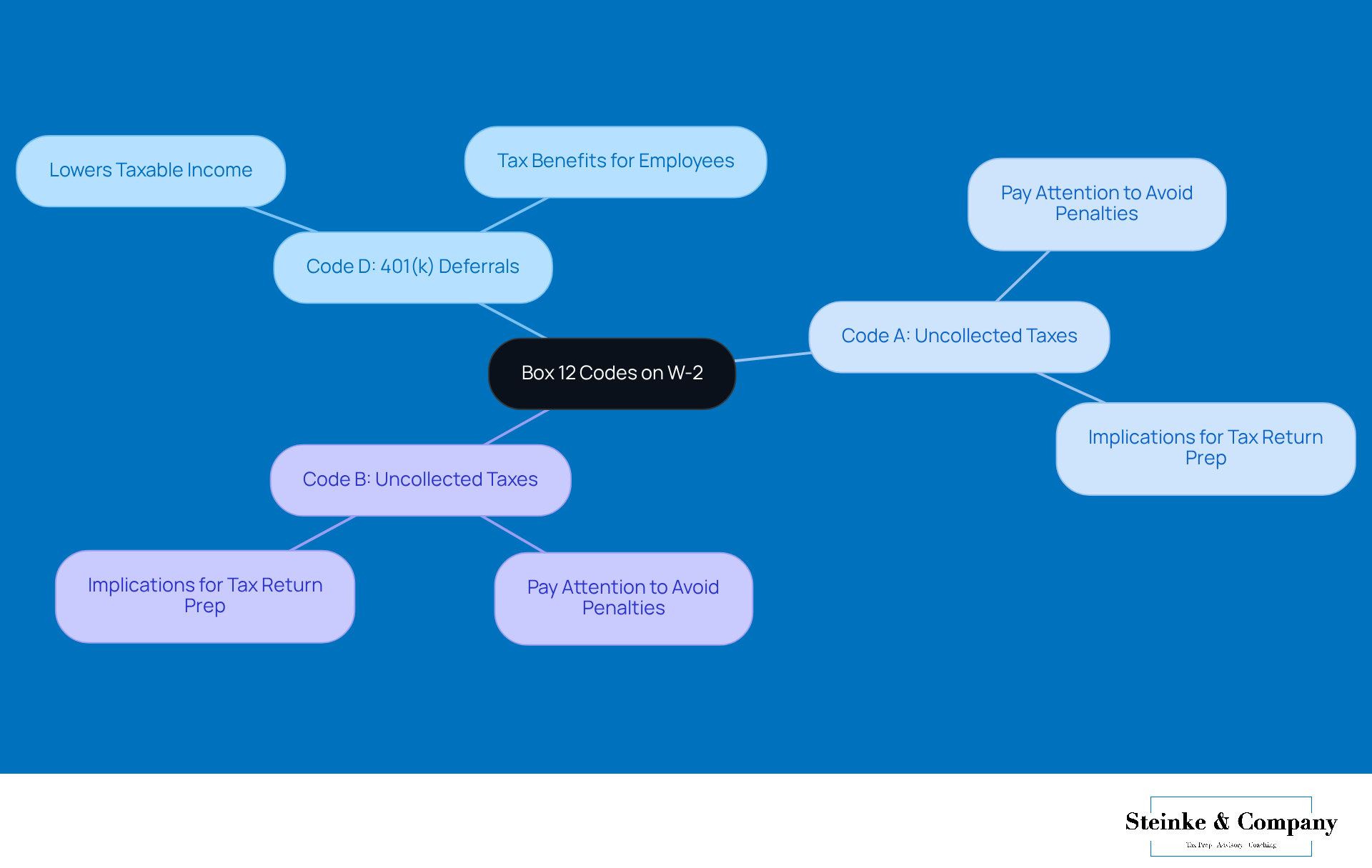Overview
Let’s chat about Box 12 on the W-2 form, shall we? You know, that little box that holds some pretty important codes? Specifically, we’re diving into the codes found in box 12d. These codes detail various types of compensation and benefits that can really impact your tax reporting and compliance.
Now, why does this matter? Well, decoding these codes accurately is super important for both employees and small business owners. It’s all about making sure your tax filings are spot on and maximizing those potential deductions. After all, nobody wants to deal with penalties related to tax compliance, right?
So, next time you’re looking at your W-2, take a moment to really understand what those codes mean. It could save you a headache down the line! And hey, if you have any questions or need a little help, don’t hesitate to reach out. We’re all in this together!
Introduction
Navigating tax forms can feel like wandering through a maze, right? Take the W-2 form, for instance—it's a key document for both employees and employers. At the center of this form is Box 12, which holds some important codes that show various types of compensation and benefits. These codes can really impact your tax situation, so it’s worth paying attention to them.
As individuals and small business owners seek financial clarity and compliance, a big question pops up: how do you decode those often-overlooked codes in Box 12? Understanding them can help you maximize deductions and steer clear of potential pitfalls. In this article, we’ll dive into why these codes matter and share some insights that could turn tax reporting from a stressful chore into a savvy strategy. So, let’s get started!
Overview of the W-2 Form and Box 12
Hey there! Let’s talk about the W-2 form, officially known as the Wage and Tax Statement. This little document is super important because it’s what employers need to give to both their employees and the IRS. It sums up an employee's annual wages and the taxes that have been taken out of their paychecks. Think of it as a key player in making sure everyone stays on the right side of tax compliance.
Now, the 12d box on W-2 is the section where things get interesting. This 12d box on W-2 highlights different types of compensation and benefits that you might not find elsewhere on the form. Each entry in Box 12 has a specific label that explains what the compensation or benefit is all about. Understanding the details in the 12d box on W-2 is crucial for accurate tax reporting, as they can affect your taxable income and even your eligibility for certain deductions or credits.
For small businesses, the W-2 form is a big deal. It’s not just about following federal tax rules; it also helps keep financial records in check. Did you know that nearly all employers must provide W-2 forms to their employees by January 31 each year? That’s right! Timely and accurate reporting is a must. Plus, case studies show that mistakes in W-2 reporting can trigger IRS inquiries, especially if the income reported doesn’t match what’s on the employee's tax return. So, getting a handle on the 12d box on W-2 and what it means is key for small business owners trying to navigate the tricky waters of tax compliance.

Decoding Box 12 Codes: What They Mean
Box 12 of the W-2 form, often referred to as the 12d box on w2, is like a little treasure chest filled with symbols that tell you about different types of compensation and benefits. Each code has its own story and implications for tax reporting. Let’s break down some of the key codes:
- Code A: This one’s about uncollected Social Security or RRTA tax on tips.
- B: Here, we have uncollected Medicare tax on tips.
- C: This code represents the taxable cost of group-term life insurance that exceeds $50,000.
- D: Elective deferrals to a 401(k) plan can really help lower your taxable income.
- DD: This shows the cost of employer-sponsored health coverage, which is super important for keeping up with healthcare regulations.
Understanding the 12d box on w2 codes is crucial because they can directly impact your tax liabilities. For example, those contributions to retirement plans (that’s Section D) can lower your taxable income, which might even help you snag some tax credits or deductions. On the flip side, while Code DD doesn’t change your taxable income, it’s still key for making sure you’re compliant with federal healthcare mandates.
So, it’s really important to get a handle on these regulations. Misunderstanding them could lead to some pretty messy tax filings. By understanding the significance of each code, especially the 12d box on w2, you can maximize your deductions and ensure everything’s reported accurately. Have you checked your W-2 form yet? It might be worth a look!

Implications of Box 12 Codes on Tax Compliance and Planning
The codes you see in the 12d box on w2 of the W-2 form are crucial for tax compliance and strategic planning, particularly for small businesses. For example, contributions under Code D, which cover 401(k) deferrals, aren’t taxed at the federal level. This means they can help lower an employee's taxable income for the year—pretty neat, right? On the flip side, if you see uncollected taxes marked by Codes A or B, you’ll want to pay extra attention during tax return prep to dodge any potential penalties.
Getting a grip on these codes is key for smart tax planning. Business owners can really make the most of the info in the 12d box on w2 to fine-tune their compensation structures and maximize those tax benefits. Plus, regularly checking the 12d box on w2 entries can help identify opportunities for tax savings while ensuring compliance with IRS regulations. Taking this proactive approach can lead to better financial outcomes, helping small businesses not just survive but thrive in today’s competitive landscape.

Conclusion
Understanding the ins and outs of the 12d box on your W-2 form is super important if you want to tackle the tricky world of tax reporting and compliance. This little section reveals key info about different types of compensation and benefits that can really impact your taxable income, deductions, and credits. By getting a handle on what each code means, you can make sure your reporting is spot on and even optimize your tax strategies.
Let’s dive into the specific codes you’ll find in Box 12. Each code, like A, B, C, D, and DD, tells its own story about tax liabilities and benefits. For example, did you know that contributions to a 401(k) plan can actually lower your taxable income? Plus, understanding the costs tied to employer-sponsored health coverage is crucial for staying compliant with federal regulations. Ignoring these codes? That could lead to mistakes that might catch the IRS’s eye, so it’s really important to pay attention to the details.
In the end, mastering the 12d box on your W-2 isn’t just about filling out forms correctly; it’s about empowering yourself and your business to make smart financial choices. By engaging with the info in Box 12, you can discover potential tax savings and ensure you’re following tax laws. If you want to thrive financially, taking a proactive approach to understanding these codes can pave the way for better outcomes and help you navigate the complexities of the tax landscape.
Frequently Asked Questions
What is the W-2 form?
The W-2 form, officially known as the Wage and Tax Statement, is a document that employers provide to their employees and the IRS. It summarizes an employee's annual wages and the taxes that have been withheld from their paychecks.
What is the significance of the W-2 form?
The W-2 form is essential for ensuring tax compliance, as it helps employees report their income accurately to the IRS and determines their tax obligations.
What information is found in Box 12 of the W-2 form?
Box 12 of the W-2 form highlights different types of compensation and benefits that may not be listed elsewhere on the form. Each entry in Box 12 has a specific label explaining the nature of the compensation or benefit.
Why is it important to understand Box 12 on the W-2 form?
Understanding the details in Box 12 is crucial for accurate tax reporting, as the information can affect taxable income and eligibility for certain deductions or credits.
What is the requirement for employers regarding the W-2 form?
Nearly all employers must provide W-2 forms to their employees by January 31 each year to ensure timely and accurate reporting.
What are the consequences of mistakes in W-2 reporting?
Mistakes in W-2 reporting can trigger IRS inquiries, especially if the income reported does not match what is on the employee's tax return.
How does the W-2 form help small businesses?
The W-2 form is important for small businesses as it helps them follow federal tax rules and maintain accurate financial records.




